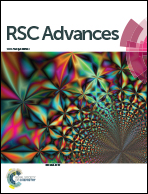Designed synthesis of LiNi0.5Mn1.5O4 hollow microspheres with superior electrochemical properties as high-voltage cathode materials for lithium-ion batteries
Abstract
LiNi0.5Mn1.5O4 hollow microspheres with designed subunits as high-voltage cathode materials for lithium-ion batteries were synthesized using dense or hollow Mn2O3 porous-spheres as self-templates. Dense Mn2O3 porous-spheres with mesosized subunits (>100 nm) were prepared by the direct decomposition of microspherical MnCO3, while the hollow and porous Mn2O3 microspheres with nanosized subunits (<30 nm) were synthesized by temperature-controlled decomposition of Mn–Ca bicarbonates followed by the selective removal of carbonates with HCl. Through a solid state reaction between Li/Ni precursors with meso/nanoporous Mn2O3, LiNi0.5Mn1.5O4 hollow spheres with different cavity size and wall structure were prepared. The as-synthesized hollow microspheres exhibited superior cyclability and high-rate capability. The best sample delivered a high and reversible discharge capacity of around 130 mA h g−1 with a capacity retention efficiency of 98.6% after 60 cycles at 1 C rate. The sample also showed high reversible capacities of 100.5 mA h g−1 even at a high current rate of 5 C. As a comparison, LiNi0.5Mn1.5O4 powders were also produced by a conventional solid state process using ball-milled Li–Ni–Mn hydroxide-oxide precursors, which showed low capacities of around 110 mA h g−1 at 1 C and greatly degraded capacities at higher current rates.


 Please wait while we load your content...
Please wait while we load your content...